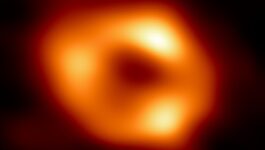
The famous image of the central black hole of the Milky Way Sgr A* would be false!
Here is Sagittarius A* at the center of our Milky Way, imaged in millimeter waves by theEvent Horizon Telescope in 2022. It is this image that should be modified according to the Japanese study. © EHT
In 2019 and 2022, for the very first time in our history, a large team of researchers succeeded in producing the first image of a supermassive black hole, firstly the disproportionate one from a distant galaxy (M87*) , then that of the Milky Way (Sgr A*).
His name? Sagittarius A*, abbreviated as Sgr A*, a monster 4 million times the mass of the Sun but only 18 times larger. Its compactness therefore makes it a star whose gravity is so strong that once its event horizon crossed – its border – nothing, neither light nor matter nor information can escape. So it's a roughly spherical shadow in space. Astronomers identify them by the impact they have on their environment. Sgr A* is 27,000 light years away from us, because that is our distance from the center of the Milky Way.
Comparison of the black hole M87* and ours Sgr A*, then of the latter with the size of the Sun and the orbit of Mercury around our star. © EHT/ESO
The image would be false: it should be more elongated, less round!
But let's come back to the announcement of this Japanese team appeared in the monthly bulletin of the Royal Astronomical Society. The team used the same 2017 data campaign from the Event Horizon Telescope and noted reconstruction errors due to artifacts. We will return later to how this image was initially produced, because it is fascinating and technically very interesting. Many algorithms had been used. Here is what the region around Sgr A* should instead look like according to this study:
The region surrounding the shadow of the black hole SgrA* is less circular and therefore more elongated according to these new interpretations © Makoto Myoshi et al (MNRAS, 2024)
Here, the team wanted to correct errors due to information gaps. It should be remembered that the image of Sgr A* had given the EHT a lot of trouble: compared to its distance from us, it is not that big. In fact, in relation to its size, its light variability is 20 seconds while that of M87* is several hours, the latter “weighing” 6 billion solar masses is much larger (see image above). The Japanese used a hybrid image reconstruction technique to avoid the famous artifacts.
They also obtained scientifically exploitable results beyond the new elongated east-west shape of the black hole. Here is what they note:
The angle of view through which we observe it is approximately 44°.
The rotation speed of the supermassive black hole is about 60% of the speed of light.
These two parameters were just very difficult to determine here on the EHT image.
But how can you make an image of a black hole if it doesn't emit any light? Is this a photo?
That's a good question. A black hole, by definition, neither emits nor releases light: that which crosses its horizon inexorably falls into it. But, just like the wind whose impact we see on the environment, it betrays itself. Harry Potter himself, made invisible by his eponymous cape, would be less clever if we threw kilos of flour where he is. Likewise, black holes radiate the dust and matter that revolves around them, and betray themselves.
But they are far away, especially the giant – supermassive – black holes housed in the centers of galaxies. The apparent size of the black hole Sgr A* is approximately that of an apple on the surface of the Moon seen from Earth! To have an image of such a small object, you need a telescope the size of the Earth. It was therefore necessary to connect telescopes together: this is interferometry. This is the principle of EHT. Several nights of observations were necessary in 2017 to obtain the famous images.
The eight radio telescopes linked by the EHT. © EHT
The waves received are millimetric and monochromatic. The image construction phase was the most complex and longest. It was necessary to create special algorithms to fill in the gaps and obtain the ring of each black hole. It is therefore not a photo in the usual sense, but an image. Katie Bouman was the media face of this reconstruction and the algorithm, but in reality there were dozens of them developing these processes.
Katie Bouman in front of the numerous hard disks of data underlying the image of the black hole M87*, the first made. © Katie Bouman
Famous photo of Katie Bouman discovering the image of M87* on her PC. © Kathie Bouman





